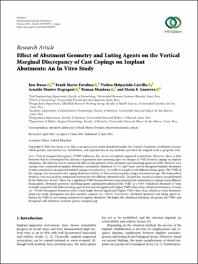Mostrar el registro sencillo del ítem
Research Article Effect of Abutment Geometry and Luting Agents on the Vertical Marginal Discrepancy of Cast Copings on Implant Abutments: An In Vitro Study
| dc.contributor.author | Rosas Diaz, Jose 1,2 | |
| dc.contributor.author | Mayta-Tovalino, Frank 3 | |
| dc.contributor.author | Malpartida-Carrillo, Violeta 2 | |
| dc.contributor.author | Munive Degregori, Arnaldo 4 | |
| dc.contributor.author | Mendoza, Roman 5 | |
| dc.contributor.author | Guerrero 6, Maria-Eugenia | |
| dc.date.accessioned | 2021-06-26T03:44:39Z | |
| dc.date.available | 2021-06-26T03:44:39Z | |
| dc.date.issued | 2021 | |
| dc.identifier.uri | https://hdl.handle.net/20.500.14308/3088 | |
| dc.description.abstract | Implant-supported restorations have shown remarkable progress in recent years and have demonstrated high sur vival rates of up to 95% with well-documented functional and esthetic results [1, 2]. Classically, implant-supported restorations can be cement-retained or screw-retained. Al though both methods have potential uses, the ideal option has yet to be established, and the selection depends on retrievability and esthetic factors [3]. Depending on the retention method, the success of the implant rehabilitation is not free of complications and re quires dynamic equilibrium between implant osseointe gration and technical and biological factors. However, based on current findings, the main complications of dental im plants are produced by biological factors [4, 5]. Furthermore, Hindawi International Journal of Dentistry Volume 2021, Article ID 9950972, 7 pages https://doi.org/10.1155/2021/9950972according to recent studies [6], the most frequent compli cations are technical and biological, being significantly higher in cement-retained restorations because of disad vantages related to vertical marginal discrepancies (VMD) and excess cement extrusion on the peri-implant tissues. In addition, in most cases, residual excess cement may promote bleeding, local inflammation, and suppuration [7, 8]. Vertical marginal discrepancy is a primordial require ment for long-term success. One author recommended [9] a VMD of less than 120 μm after coping cementation, as originally suggested for fixed prostheses. However, other in vitro studies [10] reported mean VMD values of 63.6 μm in noncemented cast copings and 116.1 μm after cast coping cementation [11]. Although there is no consensus on an acceptable maximum VMD in implant frameworks, mean values below 30 μm have been difficult to achieve clinically using conventional ceramic crowns [12]. Abbo et al. [13] reported that different factors can affect implant-supported restorations. +e luting agent thickness exposed to the oral cavity can be determined by the width, height, taper of the abutments, and type of luting agents. In the implant context, previous studies have evaluated the VMD using implant abutments regarding cast coping fabrication [10, 11], ad hesive crown cementation [9], and crown material fabri cation [14]. However, to the authors’ knowledge, little evidence is available on the effect of abutment geometry and luting agents on the VMD of copings cemented over implant abutments. Considering that control of the variables that influence the VMD and the cement line is essential, the objective of this research was to evaluate the effect of abutment geometry and luting agents on the VMD of cast copings on implant abutments. | es_PE |
| dc.format | application/pdf | es_PE |
| dc.language.iso | eng | es_PE |
| dc.publisher | International Journal of Dentistry | es_PE |
| dc.rights | info:eu-repo/semantics/openAccess | es_PE |
| dc.rights | Attribution-NonCommercial-NoDerivs 3.0 United States | * |
| dc.rights.uri | licenses/by-nc-nd/3.0/us/ | es_PE |
| dc.rights.uri | http://creativecommons.org/licenses/by-nc-nd/3.0/us/ | * |
| dc.source | Universidad Privada San Juan Bautista | es_PE |
| dc.source | Repositorio Institucional UPSJB | es_PE |
| dc.subject | Classically | es_PE |
| dc.subject | implant-supported | es_PE |
| dc.title | Research Article Effect of Abutment Geometry and Luting Agents on the Vertical Marginal Discrepancy of Cast Copings on Implant Abutments: An In Vitro Study | es_PE |
| dc.type | info:eu-repo/semantics/article | es_PE |
| dc.publisher.country | PE |


